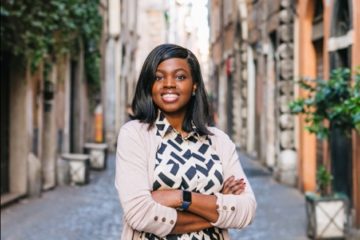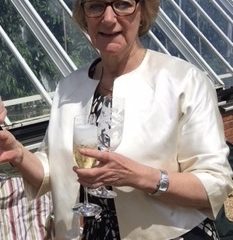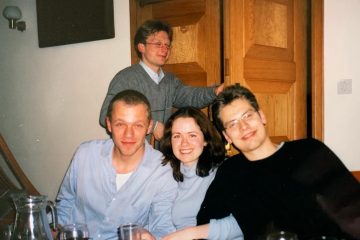The year 1969 marked a monumental change for the College. Margaret Geib Wilkinson was admitted as the first female student, putting St Edmund’s House ahead of all the all-male Colleges in the admission of women. Now, fifty years later, we look back to those times and forward into a bright future, as we strive for ever greater inclusivity and equality.
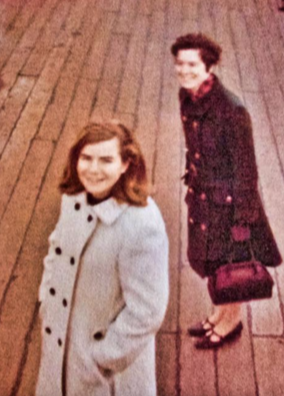
That would be me. In 1969. How unlikely it was, that a young Roman Catholic American laywoman got to explore the imponderables of her place in the future of the life of the church by running off to England’s Cambridge University. One of its colleges, St. Edmund’s House, had accepted me as a member to read in Divinity (Theology Tripos, Part III).
How unlikely? About as unlikely as landing on the moon…an event I listened to on a transistor radio as it happened, while sitting on a bench on the flanks of Kings College Chapel. I was attending a madrigal concert on the Backs, so I could watch the moon float in the blue sky’s descent into dusk as I listened to both radio and concert. I haven’t forgotten that evening of July 20, 1969 for a moment, in important part because the folks back at St. Edmund’s were as excited as I about the coming together of it all, reflecting some of the glory of the accomplishment of the scientists onto me.
My presence there had everything to do with the fact that St. Edmund’s, formerly a residence for Roman Catholic priests attending various University colleges, had recently transmuted itself into an ecumenical graduate college, thus fulfilling a shared Roman Catholic and Protestant desire to have a fully flourishing Christian institute at the University. This decision, an important and early response to Vatican II initiatives, was
congruent with my experience of church in the United States.
When I was an undergraduate at Stanford University active in the university Roman Catholic community at the Newman Center, the first visiting professor in Roman Catholic theology at Stanford, Father Daniel O’Hanlon, S.J., told us that lay people with advanced degrees in theology would soon be on the scene. Michael Novak, then a young lay theologian, became the first regular member of the faculty of the Department of Religion at Stanford. He mentored a number of us as we aimed for graduate studies in theology (Yale and Chicago Divinity Schools; St. Michael’s inToronto,Catholic University’s Department of Religious Studies in Washington D.C., and the University of Notre Dame, South Bend, Indiana). I earned my Masters Degree in Theology from Notre Dame, and had the pleasure of learning from John Dunne, C.S.C. (systematic theology), and John L. McKenzie, S.J. (Scripture). Joseph Blenkinsopp taught the introductory course in the New Testament.
Blenkinsopp, an Oxford man visiting at Notre Dame from Vanderbilt, was the first one to suggest I go to a place like Oxford or Cambridge to enrich my theological (and life) education if possible. Iltud Evans, O.P., was living at St. Albert’s College in Oakland, California, when he told me that his former community at Blackfriars, Cambridge shared a fence, with a gate, next to St. Edmund’s House. He thought St. Edmund’s might take me, and wrote a letter to them on my behalf.
I found the intellectual, communal, and liturgical graces of St. Edmund’s entirely congenial. I remained quite conscious that I was the first female student member of the college, in large part because of the interest and kindness that fact stirred up in my colleagues at the college. But I became, in fact, one of a small group of women already there when I arrived in early June.
The several German religious sisters that took care of the entire household were always cordial to me. Elizabeth Stopp, on the French faculty of the University and a Fellow of the college, was full of charm and insight. Most importantly,Anita Pampusch, then a religious sister pursuing her Ph.D. in the Philosophy of Science at Notre Dame, had arrived at St. Edmund’s a few weeks before me to do research on Isaac Newton (translating and reading his unpublished papers in the Anderson Room of the University Library). She was an acquaintance of mine from my days at Notre Dame, whose roots in St. Paul, Minnesota, and environs were even deeper than mine. She was one of those who, along with Canon Sweeney, welcomed me to the campus the day I arrived by cab from the train station. Initially, she and I shared the second floor of the campus cottage, where we had digs above the quarters of an undergraduate student and his wife.
In the kind of community St. Edmund’s was at the time, I never felt alone because Anita and I really hit it off.The college was a community of individual scholars following various academic pathways, within the context of an ecumenical vision. Everyone was on an individual track of study for the most part, so we came together to share our stories of the day without exactly ‘going to school’ together. It was refreshing. People were kind and helpful, and full of conversation.Anita and I agreed that we could spend any given day visiting with members of the college community from breakfast until gatherings for hot chocolate after the pubs closed. My studies were structured around two tutorials, with one paper due each week alternatively for one professor or the other. I delighted in looking out the turret of the 19th century part of St. John’s while its dean asked me impossible questions about which I was to produce an essay in two weeks. “Was Romanticism a development of or reaction against The Enlightenment?” He would then pull one volume or another from his floor to ceiling collection of books and suggest I read certain sections of them.This was fun. I was supposed to sit in on a class on 19th century English Church history given by a great lecturer, but I couldn’t stand listening in that format at the time.The tutorial format was “heavens opening from above”.
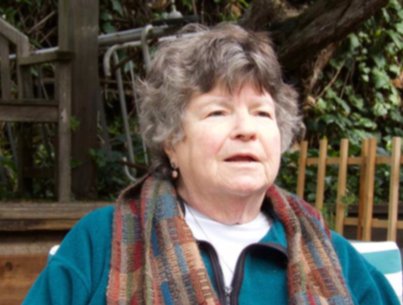
I presume, without really knowing, that some people whose history was intertwined with that of St. Edmunds would have been dismayed at the idea that a woman was a member of the college. No one ever talked with, or reacted to me along those lines, at least in a way that made me aware of it.The college’s decision to become ecumenical in orientation, and therefore more accepting of female students, was a recent one at the time I arrived. From my Roman Catholic perspective, the blessings at St. Edmund’s at that moment were clearly part of the right and proper discernment of the signs of the times, a product of the goodness in the Roman Catholic community unleashed at Vatican II, and received and encouraged by other Christian communities. I was in the right place at the right time. Laywomen, especially those studying theology, were an anomaly compared to religious sisters. St. Edmund’s made it easy to feel that the vocation developing in me made sense as but one more expression of a longing for God.“Love bade me welcome….so I did sit and eat” (George Herbert,“Love III”).
Thank you, St. Edmund’s!
– Margie Wilkinson
